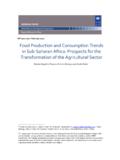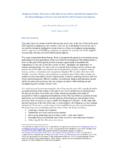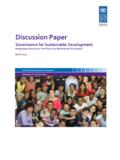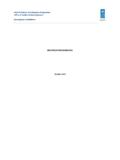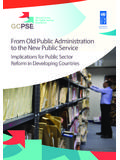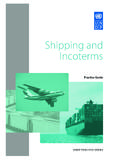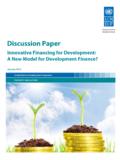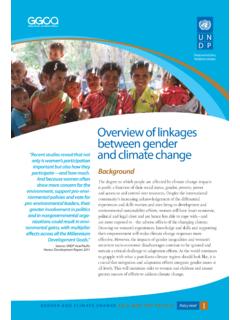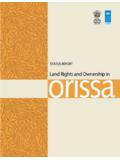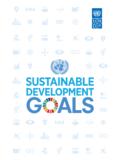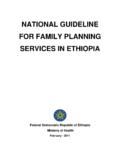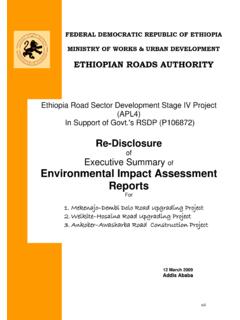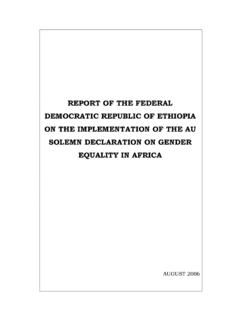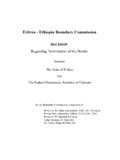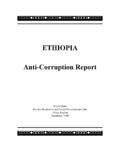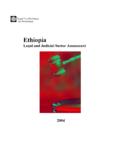Transcription of Ethiopia’s Climate-Resilient Green Economy - UNDP
1 ethiopia s Climate-Resilient Green Economy Green Economy strategy federal democratic republic OF ethiopia CONFIDENTIAL federal democratic republic of ethiopia I Contents Foreword III Executive summary 1 The vision: Achieve middle-income status by 2025 in a Climate-Resilient Green Economy 5 The challenge: Realise economic development goals in a sustainable way 11 The plan: Follow a Green growth path that fosters development and sustainability 19 The ambition is to build a Green Economy 19 The development of a Green Economy will be based on four pillars 20 Agriculture: Improving crop and livestock production practices for higher food security and farmer income while reducing emissions 22 Forestry: Protecting and re-establishing forests for their economic and ecosystem services, including as carbon stocks 24 Power: Expanding electricity generation form renewable energy for domestic and regional markets 25 Transport, industrial sectors and buildings.
2 Leapfrogging to modern and energy efficient technologies 26 Building a Green Economy offers cost-efficient abatement potential while promoting GTP targets 28 Making it happen: ethiopia s action plan to create a Green Economy 45 federal democratic republic of ethiopia II Appendices 59 Approach and methodology 61 Electric Power 78 Green Cities and Buildings 91 Forestry 101 Livestock 117 Soil 134 Industry 151 Transport 165 List of References 181 federal democratic republic of ethiopia III Foreword ethiopia is experiencing the effects of climate change. Besides the direct effects such as an increase in average temperature or a change in rainfall patterns, climate change also presents the necessity and opportunity to switch to a new, sustainable development model.
3 The Government of the federal democratic republic of ethiopia has therefore initiated the Climate-Resilient Green Economy (CRGE) initiative to protect the country from the adverse effects of climate change and to build a Green Economy that will help realise its ambition of reaching middle-income status before 2025. Since February 2011, the CRGE initiative, under the leadership of the Prime Minister s Office, the Environmental Protection Authority, and the Ethiopian Development Research Institute, has been developing a strategy to build a Green Economy . Seven sectoral teams involving more than 50 experts from more than 20 leading government institutions have been driving the initiative.
4 The objective is to identify Green Economy opportunities that could help ethiopia reach its ambi-tious growth targets while keeping greenhouse gas emissions low. The government intends to attract development partners to help implement this new and sustainable growth model. This report summarises the findings of the CRGE initiative, and particularly focuses on outlining the plan to develop a Green Economy . The document does not cover climate resilience, which will be added over the coming months. This strat-egy has been extensively discussed during the previous two months of regional and sectoral consultations to ensure national alignment on priorities, confirm initial findings, create awareness, and join forces.
5 This document reflects the work of the CRGE initiative as well as the outcome of the consultation process. Addis Ababa, November 2011 federal democratic republic of ethiopia V List of abbreviations Abbreviation Stands for B5 5% biodiesel content of transport diesel BAU Business-as-usual (scenario) BRT Bus-rail transit CAPEX Capital expenditure or investment rather than a cost CDM Clean Development Mechanism of the Kyoto Protocol CEM IV/B Grade IV cement CFL Compact florescent lights CO2 Carbon dioxide, the most important greenhouse gas CO2e Carbon dioxide equivalent COP Conference of the Parties.
6 The annual summit of UNFCCC CRGE ethiopia s Climate-Resilient Green Economy initiative CCS Carbon capture and storage CSA Central Statistical Authority E15 15% ethanol content of transport gasoline EDRI Ethiopian Development Research Institute EEPCo Ethiopian Electric Power Corporation EIAR Ethiopian Institute of Agricultural Research EPA Environmental Protection Authority ETS European Trading Scheme EWCA Ethiopian Wildlife Conservation Authority FAO Food and Agriculture Organisation FDI Foreign Direct Investment FES Fuel efficiency standards FRC Forestry Research Centre GDP Gross domestic product GGGI Global Green Growth Institute GHG Greenhouse gases (mainly CO2, N2O, and methane) GIZ Deutsche Gesellschaft f r Internationale Zusammenarbeit GoE Government of ethiopia Gt Gigatonne ( , billon metric tonnes) GTP Growth and Transformation Plan GVA Gross value added Ha Hectare (ha)
7 IBC Institute of Biodiversity Conservation IPCC Intergovernmental Panel on Climate Change federal democratic republic of ethiopia VI Abbreviation Stands for KWh Kilowatt hour of electricity LPG Liquefied petroleum gas LRT Light-rail transit MIC Middle income country MoA Ministry of Agriculture MoFED Ministry of Finance and Economic Development MoI Ministry of Industry MoT Ministry of Trade MoUDC Ministry of Urban Development and Construction MoWE Ministry of Water and Energy MRV Measuring, reporting, and verification MSC Ministerial Steering Committee of CRGE initiative Mt CO2e Million metric tonnes of carbon dioxide equivalent Mt Megatonne ( , million metric tonnes)
8 NAMA Nationally appropriate mitigation action N2O Nitrous oxide, a greenhouse gas NGO Nongovernmental organisation NPV Net Present Value OPC Ordinary Portland Cement Opex Operating expenditure or cost PASDEP Plan for accelerated and sustained development to end poverty PPC Pozzolana Portland Cement Q1/Q2/Q3/Q4 First/second/third/fourth quarter of the year REDD+ Reducing Emissions from Deforestation and Forest Degradation RELS Reducing Emissions from the Livestock Sector R-PP Readiness Preparation Proposal STC Sub-Technical Committee of CRGE initiative t Tonne TC Technical Committee of CRGE initiative TCO Total cost of ownership TWh Terawatt
9 Hour of electricity (tera = one trillion) UNDP United Nations Development Programme UNFCCC United Nations Framework Convention on Climate Change WBISPP Woody Biomass Inventory and Strategic Planning Project federal democratic republic of ethiopia VII federal democratic republic of ethiopia VIII Technical note This strategy is based on the data and sources of information available to the sub-technical committees as of August 2011. The BAU projections and calculation of abatement potential and abatement cost follow a consistent methodology as described in the appendix. As most of the calculations are performed on a sectoral level, they do not necessarily follow specific project-level protocols of setting baseline emission scenarios and abatement outcomes, as is for example done in the context of carbon finance schemes.
10 Rather, the BAU calculations should be understood as a strategic emission projection against which the sectoral mitigation programmes are drafted. The sectoral mitigation initiatives and the associated costs should be understood as an initial identification and estimation of sectoral abatement potential and a base for strategic decisions regarding their implementation and required support. Although they form part of an overall strategy in building a Climate-Resilient Green Economy , and the government is committed to creating a supportive environment for them, the individual initiatives should not be understood as immediately mandatory government policies.
